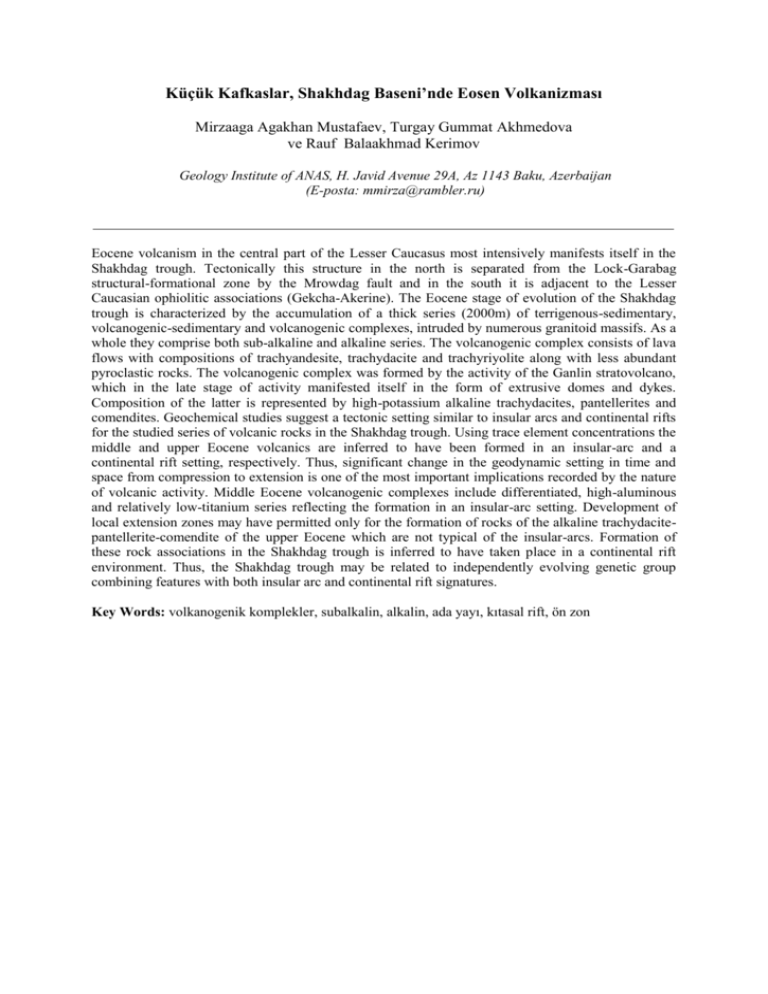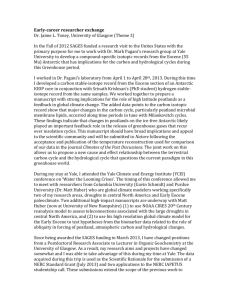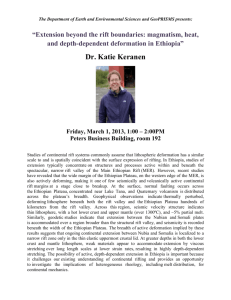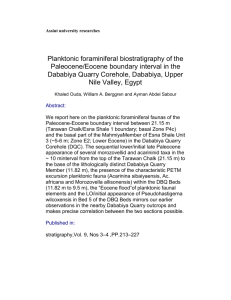Peculiarities of formation of Eocene volcanism in the Shakhdag
advertisement

Küçük Kafkaslar, Shakhdag Baseni’nde Eosen Volkanizması Mirzaaga Agakhan Mustafaev, Turgay Gummat Akhmedova ve Rauf Balaakhmad Kerimov Geology Institute of ANAS, H. Javid Avenue 29A, Az 1143 Baku, Azerbaijan (E-posta: mmirza@rambler.ru) Eocene volcanism in the central part of the Lesser Caucasus most intensively manifests itself in the Shakhdag trough. Tectonically this structure in the north is separated from the Lock-Garabag structural-formational zone by the Mrowdag fault and in the south it is adjacent to the Lesser Caucasian ophiolitic associations (Gekcha-Akerine). The Eocene stage of evolution of the Shakhdag trough is characterized by the accumulation of a thick series (2000m) of terrigenous-sedimentary, volcanogenic-sedimentary and volcanogenic complexes, intruded by numerous granitoid massifs. As a whole they comprise both sub-alkaline and alkaline series. The volcanogenic complex consists of lava flows with compositions of trachyandesite, trachydacite and trachyriyolite along with less abundant pyroclastic rocks. The volcanogenic complex was formed by the activity of the Ganlin stratovolcano, which in the late stage of activity manifested itself in the form of extrusive domes and dykes. Composition of the latter is represented by high-potassium alkaline trachydacites, pantellerites and comendites. Geochemical studies suggest a tectonic setting similar to insular arcs and continental rifts for the studied series of volcanic rocks in the Shakhdag trough. Using trace element concentrations the middle and upper Eocene volcanics are inferred to have been formed in an insular-arc and a continental rift setting, respectively. Thus, significant change in the geodynamic setting in time and space from compression to extension is one of the most important implications recorded by the nature of volcanic activity. Middle Eocene volcanogenic complexes include differentiated, high-aluminous and relatively low-titanium series reflecting the formation in an insular-arc setting. Development of local extension zones may have permitted only for the formation of rocks of the alkaline trachydacitepantellerite-comendite of the upper Eocene which are not typical of the insular-arcs. Formation of these rock associations in the Shakhdag trough is inferred to have taken place in a continental rift environment. Thus, the Shakhdag trough may be related to independently evolving genetic group combining features with both insular arc and continental rift signatures. Key Words: volkanogenik komplekler, subalkalin, alkalin, ada yayı, kıtasal rift, ön zon Peculiarities of Formation of Eocene Volcanism in the Shakhdag Trough in the Lesser Caucasus Mirzaaga Agakhan Mustafaev, Turgay Gummat Akhmedova & Rauf Balaakhmad Kerimov Geology Institute of ANAS, H. Javid Avenue 29A, Az 1143 Baku, Azerbaijan (E-mail: mmirza@rambler.ru) Eocene volcanism in the central part of the Lesser Caucasus most intensively manifests itself in the Shakhdag trough. Tectonically this structure in the north is separated from the Lock-Garabag structural-formational zone by the Mrowdag fault and in the south it is adjacent to the Lesser Caucasian ophiolitic associations (Gekcha-Akerine). The Eocene stage of evolution of the Shakhdag trough is characterized by the accumulation of a thick series (2000m) of terrigenous-sedimentary, volcanogenic-sedimentary and volcanogenic complexes, intruded by numerous granitoid massifs. As a whole they comprise both sub-alkaline and alkaline series. The volcanogenic complex consists of lava flows with compositions of trachyandesite, trachydacite and trachyriyolite along with less abundant pyroclastic rocks. The volcanogenic complex was formed by the activity of the Ganlin stratovolcano, which in the late stage of activity manifested itself in the form of extrusive domes and dykes. Composition of the latter is represented by highpotassium alkaline trachydacites, pantellerites and comendites. Geochemical studies suggest a tectonic setting similar to insular arcs and continental rifts for the studied series of volcanic rocks in the Shakhdag trough. Using trace element concentrations the middle and upper Eocene volcanics are inferred to have been formed in an insular-arc and a continental rift setting, respectively. Thus, significant change in the geodynamic setting in time and space from compression to extension is one of the most important implications recorded by the nature of volcanic activity. Middle Eocene volcanogenic complexes include differentiated, high-aluminous and relatively low-titanium series reflecting the formation in an insular-arc setting. Development of local extension zones may have permitted only for the formation of rocks of the alkaline trachydacite-pantellerite-comendite of the upper Eocene which are not typical of the insular-arcs. Formation of these rock associations in the Shakhdag trough is inferred to have taken place in a continental rift environment. Thus, the Shakhdag trough may be related to independently evolving genetic group combining features with both insular arc and continental rift signatures. Key Words: volcanogenic complexes, subalkaline, alkaline, insular-arc, continental rifts, frontal zone






